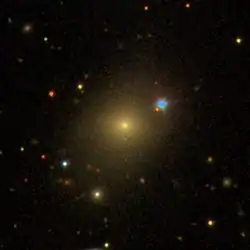NGC 6047
NGC 6047 is an elliptical galaxy located about 430 million light-years away[2] in the constellation Hercules.[3] It was discovered by astronomer Lewis Swift on June 27, 1886.[4] NGC 6047 is a member of the Hercules Cluster.[5][6][7]
| NGC 6047 | |
|---|---|
 SDSS image of NGC 6047. | |
| Observation data (J2000 epoch) | |
| Constellation | Hercules |
| Right ascension | 16h 05m 09.0s[1] |
| Declination | 17° 43′ 48″[1] |
| Redshift | 0.031262[1] |
| Helio radial velocity | 9372 km/s[1] |
| Distance | 131.4 Mpc (429 Mly)[1] |
| Group or cluster | Hercules Cluster |
| Apparent magnitude (V) | 14.55[1] |
| Characteristics | |
| Type | E+, cD[1] |
| Size | ~170,000 ly (52 kpc)[1] (estimated)[1] |
| Apparent size (V) | 1.1 x 0.8[1] |
| Notable features | radio jet |
| Other designations | |
| CGCG 108-111, DRCG 34-62, 4C +17.66, PKS 1602+178, MCG+3-41-87, PGC 57033[1] | |
Morphology
NGC 6047 has a peculiar morphology[5][8][9]which suggests it has undergone a recent merger.[6][7][10]
Radio jets
NGC 6047 has two radio jets[6][7] and is classified as a FR I radio galaxy.[9]
The jets appear to have a Z-shaped structure.[5]
Interaction with NGC 6045
NGC 6047 may be interacting with NGC 6045 which lies around ~320,000 ly (97 kpc) away.[8]
See also
References
- "NASA/IPAC Extragalactic Database". Results for NGC 6047. Retrieved 2018-08-16.
- "Your NED Search Results". ned.ipac.caltech.edu. Retrieved 2018-08-20.
- "Revised NGC Data for NGC 6047". spider.seds.org. Retrieved 2018-08-21.
- "New General Catalog Objects: NGC 6000 - 6049". cseligman.com. Retrieved 2018-08-21.
- Feretti, L.; Giovannini, G. (February 1988). "NGC 6047 - Radio source interaction with the environment". Astronomy and Astrophysics. 191: 21. Bibcode:1988A&A...191...21F. ISSN 0004-6361.
- Liuzzo, E.; Giovannini, G.; Giroletti, M.; Taylor, G. B. (June 2010). "Parsec-scale properties of brightest cluster galaxies". Astronomy and Astrophysics. 516: A1. arXiv:1002.1380. Bibcode:2010A&A...516A...1L. doi:10.1051/0004-6361/200913888. ISSN 0004-6361. S2CID 14536396.
- Liuzzo, E.; Giovannini, G.; Giroletti, M. (March 2011). "Nuclear properties of Brightest Cluster Galaxies: results and new observations for two peculiar cases". arXiv:1103.0450 [astro-ph.CO].
- Huang, Zhenping; Sarazin, Craig L. (April 1996). "A High-Resolution ROSAT X-Ray Study of the Hercules Cluster". The Astrophysical Journal. 461: 622. Bibcode:1996ApJ...461..622H. doi:10.1086/177090. ISSN 0004-637X.
- Heckman, T. M.; Smith, Eric P.; Baum, Stefi A.; van Breugel, W. J. M.; Miley, G. K.; Illingworth, G. D.; Bothun, G. D.; Balick, B. (December 15, 1986). "Galaxy collisions and mergers - The genesis of very powerful radio sources?". The Astrophysical Journal. 311: 526–547. Bibcode:1986ApJ...311..526H. doi:10.1086/164793. ISSN 0004-637X.
- Dickey, John M. (June 1997). "A VLA Survey of the Hercules Cluster.I.The HI Data". The Astronomical Journal. 113: 1939. Bibcode:1997AJ....113.1939D. doi:10.1086/118408. ISSN 0004-6256.
External links
- NGC 6047 on WikiSky: DSS2, SDSS, GALEX, IRAS, Hydrogen α, X-Ray, Astrophoto, Sky Map, Articles and images
This article is issued from Wikipedia. The text is licensed under Creative Commons - Attribution - Sharealike. Additional terms may apply for the media files.